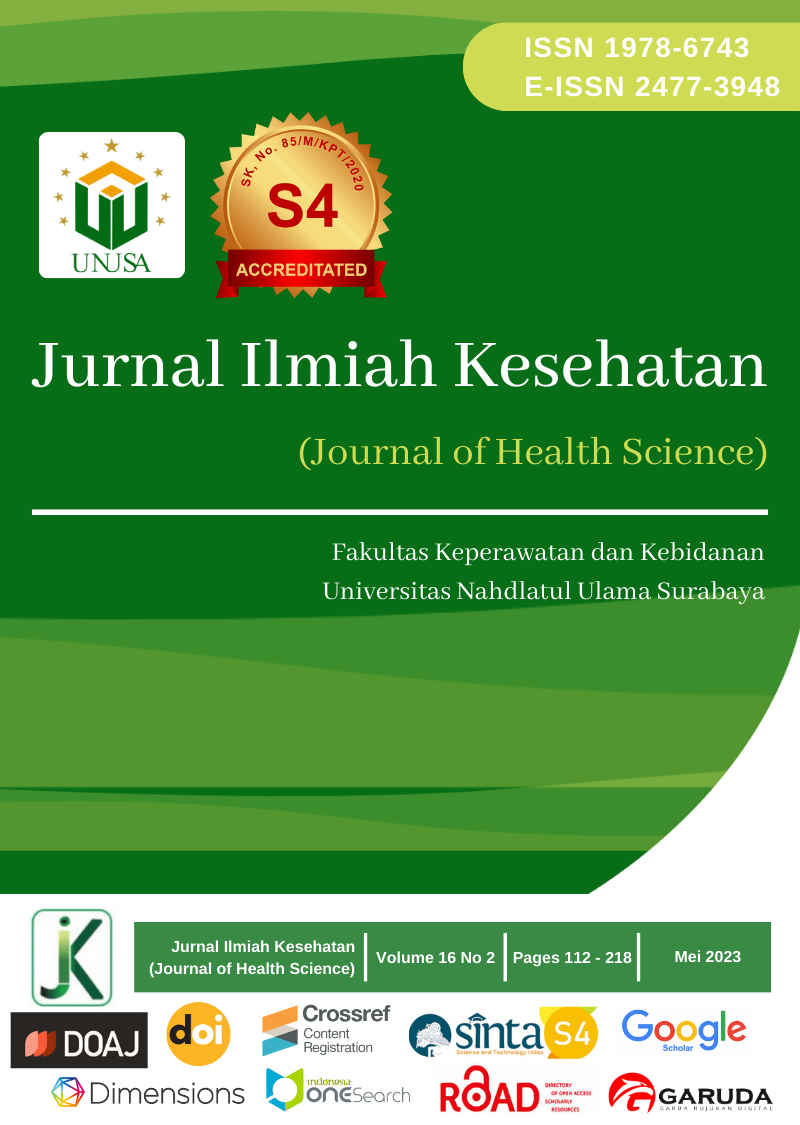The Effect of REKIS Innovation in Increasing The Resilience of Mothers Who Have Stunted Children
Main Article Content
Abstract
The community still perceives stunting as a negative stigma. It potentially risks the mental health of both the child and the mother. Mother resilience is crucial to deal with biopsychosocial stressors because of stunting. This research analyzes the effects of the REKIS (Resiliensi Komunitas Ibu Dengan Anak Stunting) innovation on knowledge, attitudes, behavior, and resilience regarding stunting in mothers with stunted children. This research was a quantitative study with a quasi-experimental design. The population was mothers with children diagnosed with stunting in the Gilingan Surakarta Health Center. There were 60 respondents with the total sampling technique, 30 in the control and 30 in the intervention groups. Pre-test and post-test data were collected using knowledge, attitude, behavior, and maternal resilience questionnaires. Data analysis used the Wilcoxon Rank Sum Test to test the difference in mean scores between the control and intervention groups. In addition, the Wilcoxon Signed Rank Test analyzes the difference in mean scores between the pre-and post-test. The results showed that all respondents had similar demographic characteristics (age, occupation, and education). Both groups had significant differences in pre and post-test mean scores on maternal knowledge, attitudes, behavior, and resilience (p<0.05). Significant differences were in the overall pre- and post-test mean scores on maternal knowledge, attitudes, and resilience (p<0.05). However, there was no significant difference in the pre-and post-test on maternal behavior. In conclusion, The REKIS innovation can increase the resilience of mothers with stunted children. It improves maternal knowledge and attitudes regarding stunting.
Downloads
Article Details
Copyright (c) 2023 Grhasta Dian Perestroika, Niken Bayu Argaheni, Rizka Ayu Setyani, Mustikaningtyas, Titi Ngudiati, Fika Lilik Indrawati

This work is licensed under a Creative Commons Attribution-ShareAlike 4.0 International License.
References
Ali, A. (2021). Current status of malnutrition and stunting in Pakistani children: what needs to Be done? Journal of the American College of Nutrition, 40(2), 180–192. DOI: https://doi.org/10.1080/07315724.2020.1750504
Black, R. E., Allen, L. H., Bhutta, Z. A., Caulfield, L. E., de Onis, M., Ezzati, M., Mathers, C., & Rivera, J. (2008). Maternal and child undernutrition: global and regional exposures and health consequences. The Lancet, 371(9608), 243–260. https://doi.org/10.1016/S0140-6736(07)61690-0 DOI: https://doi.org/10.1016/S0140-6736(07)61690-0
de Onis, M., & Branca, F. (2016). Childhood stunting: a global perspective. Maternal & Child Nutrition, 12(Suppl 1), 12–26. https://doi.org/10.1111/mcn.12231 DOI: https://doi.org/10.1111/mcn.12231
Dewey, K. G., & Begum, K. (2011). Long-term consequences of stunting in early life. Maternal & Child Nutrition, 7, 5–18. https://doi.org/10.1111/j.1740-8709.2011.00349.x DOI: https://doi.org/10.1111/j.1740-8709.2011.00349.x
Greeff, A. P., & Thiel, C. (2012). Resilience in families of husbands with prostate cancer. Educational Gerontology, 38(3), 179–189. DOI: https://doi.org/10.1080/03601277.2010.532068
Habimana, S., & Biracyaza, E. (2019). Risk Factors Of Stunting Among Children Under 5 Years Of Age In The Eastern And Western Provinces Of Rwanda: Analysis Of Rwanda Demographic And Health Survey 2014/2015. Pediatric Health, Medicine and Therapeutics, Volume 10, 115–130. https://doi.org/10.2147/PHMT.S222198 DOI: https://doi.org/10.2147/PHMT.S222198
Hendriani, W. (2022). Resiliensi psikologi sebuah pengantar. Prenada Media.
Jamil, K. S. (2020). Stigma Ibu Dalam Merawat Anak Stunting Berbasis Teori Swanson Di Wilayah
Puskesmas Arosbaya. STIKes Ngudia Husada Madura.
Kementerian Kesehatan RI. (2021). Buku Saku Hasil Studi Status Gizi Indonesia (SSGI) Tingkat
Nasional, Provinsi, dan Kabupaten/Kota Tahun 2021 (Kementerian Kesehatan RI (ed.)). Kusumaningrum, S., Anggraini, M. T., & Faizin, C. (2022). Hubungan pengetahuan dan dukungan
keluarga dengan perilaku pencegahan stunting pada ibu hamil.
Lee, Y., & Li, J. Q. (2021). The role of communication transparency and organizational trust in publics’ perceptions, attitudes and social distancing behaviour: A case study of the COVID‐19 outbreak. Journal of Contingencies and Crisis Management, 29(4), 368–384. DOI: https://doi.org/10.1111/1468-5973.12354
Mzumara, B., Bwembya, P., Halwiindi, H., Mugode, R., & Banda, J. (2018). Factors associated with stunting among children below five years of age in Zambia: evidence from the 2014 Zambia demographic and health survey. BMC Nutrition, 4(1), 1–8. DOI: https://doi.org/10.1186/s40795-018-0260-9
Notoatmodjo, S. (2010). Ilmu Perilaku Kesehatan. Rineka Cipta.
Palacio G, C., Krikorian, A., Gómez-Romero, M. J., & Limonero, J. T. (2020). Resilience in caregivers:
A systematic review. American Journal of Hospice and Palliative Medicine®, 37(8), 648–658.
Rahmawati, I., Sudargo, T., & Paramastri, I. (2007). Pengaruh penyuluhan dengan media audio visual terhadap peningkatan pengetahuan, sikap dan perilaku ibu balita gizi kurang dan buruk di Kabupaten Kotawaringin Barat Propinsi Kalimantan Tengah. Jurnal Gizi Klinik Indonesia, 4(2), 69–77. DOI: https://doi.org/10.22146/ijcn.17478
Rosiyati, E., Pratiwi, E. A. D., Poristinawati, I., Rahmawati, E., Nurbayani, R., Lestari, S., Wardani, P. S., & Nugroho, M. R. (2019). Determinants of Stunting Children (0-59 Months) in Some Countries in Southeast Asia. Jurnal Kesehatan Komunitas, 4(3), 88–94. https://doi.org/10.25311/keskom.Vol4.Iss3.262 DOI: https://doi.org/10.25311/keskom.Vol4.Iss3.262
Semiatin, A. M., & O’Connor, M. K. (2012). The relationship between self-efficacy and positive aspects of caregiving in Alzheimer’s disease caregivers. Aging & Mental Health, 16(6), 683–688. DOI: https://doi.org/10.1080/13607863.2011.651437
Victora, C. G., Adair, L., Fall, C., Hallal, P. C., Martorell, R., Richter, L., & Sachdev, H. S. (2008). Maternal and child undernutrition: consequences for adult health and human capital. The Lancet, 371(9609), 340–357. https://doi.org/10.1016/S0140-6736(07)61692-4 DOI: https://doi.org/10.1016/S0140-6736(07)61692-4
Vonaesch, P., Tondeur, L., Breurec, S., Bata, P., Nguyen, L. B. L., Frank, T., Farra, A., Rafaï, C., Giles- Vernick, T., Gody, J. C., Gouandjika-Vasilache, I., Sansonetti, P., & Vray, M. (2017). Factors associated with stunting in healthy children aged 5 years and less living in Bangui (RCA). PLOS ONE, 12(8), e0182363. https://doi.org/10.1371/journal.pone.0182363 DOI: https://doi.org/10.1371/journal.pone.0182363
WHO. (2018). Level and Trends Child in Malnutrition.
Widiastuti, A., Ulkhasanah, M. E., & Sani, F. N. (2022). Stigma pada Anak Stunting Beresiko terhadap
Kesehatan Mental. Jurnal Keperawatan, 14(4), 1213–1220.
Yulia, I. (2018). Optimalisasi Penggunaan Media Sosial Dalam Pemasaran Sosial Dan Komunikasi Perubahan Perilaku (Suatu Pendekatan Studi Literature Review). HEARTY: Jurnal Kesehatan Masyarakat, 6(2). DOI: https://doi.org/10.32832/hearty.v6i2.1276





